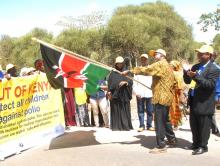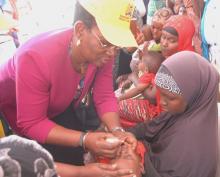Polio campaigns kick off in Kenya
Jan 18, 2017 - Kenya has kicked off its 2017 immunization effort with a polio campaign this week, targeting 2.9 million children aged five years and under.
The campaign, January 18-22, is targeting 15 counties that are that are considered on higher risk and vulnerable and which are mainly situated in remote, hard-to-reach and border areas. The campaign also covers Nairobi County, the travel hub that brings the rest of the world into Kenya. The other counties include: Isiolo, Samburu, West Pokot, Turkana, Marsabit, Garissa, Tana River, Wajir, Lamu, Bungoma, Busia and Uasin Gishu, Trans Nzoia, Nairobi and Mandera.
The campaign or supplementary immunization activity (SIA) marks the country’s commitment to avert any possible polio outbreak given renewed threats of polio due to an outbreak in Borno State Nigeria last July and August. Since then, countries in the Horn of Africa region have committed to initiate polio campaigns to ensure the region continues to be safe. The cases in Nigeria became evident after the conflict area associated with the Boko Haram insurgents in Borno State became more accessible. Before then, Nigeria, Africa and the global polio eradication community had enjoyed some relief after Nigeria was removed from the list of polio endemic countries in 2015 after going without a case for a year.
Speaking at the national launch in Isiolo County, Director of Health Services Dr Jackson Kioko said there was need to vaccinate children in this campaign in order to improve the overall population immunity especially in areas where routine vaccination coverage was low. He said the outbreak in Nigeria last August had put children in Kenya at risk. He gave assurance that the vaccine used for the campaign was safe and was exactly the same as that used for routine vaccination in all health facilities, public or private. He said about three quarters of children under two (73 per cent) were fully immunized while the rest were either unimmunized or under-immunized.
WHO Country Representative Dr Rudi Eggers said that until poliovirus transmission was interrupted in all endemic countries, all countries including Kenya still remained at risk of importation of polio.
“This is particularly true of vulnerable countries (including some of Kenya’s neighbours) with weak public health and immunization services and travel or trade links to endemic countries”.
In addition, he said due to the low polio vaccination coverage rates found in some counties, there were many children left vulnerable to the disease even in Kenya.
He called on the need for a comprehensive approach in which all eligible children (0-2 years) are reached with all the life-saving routine immunization vaccines (BCG, Measles, Pentavalent, Rota, Yellow Fever, IPV and others), regardless of where they are born, who they are or where they live. In remarks read by Dr Iheoma Onuekwusi, EPI lead WHO Kenya, Dr Eggers said evidence had shown that one out of every five children were missed by routine immunization services in Kenya as a whole and many more in remote, and hard to reach areas in Kenya. He said for effective disease control and eradication, there was need to strengthen and address gaps in routine immunization services and the surveillance system.
“To secure and maintain a polio free world, we must reach every last child with the polio vaccine through Routine Immunization services and during immunization campaigns”.
The launch was attended by among others Isiolo County governor, Godana Doyo who said vaccination was a sure way of protecting the child’s health and future.
Polio ambassador in Isiolo County Mohamed Abdulahi said: “If my parents had enabled my vaccination, I would not be dependent on other people for mobility (“Wazazi wangu wangenipatia chanjo ya polio singekuwa nasukumwa na gari ya kusukumwa”).
National polio ambassador Senator Harold Kipchumba urged parents and neighbours to get their children vaccinated adding that once infected by the virus, the disability could not be reversed.
“All you need are two drops to protect the child from polio,” he said.
Dr Eggers also said no efforts were being spared to interrupt transmission of the Wild Polio Virus (WPV) in the endemic countries. These are Pakistan, Afghanistan and Nigeria. In 2016, 35 polio cases caused by wild type virus were detected from these three countries he added, in a speech read by Dr Iheoma Onuekwusi, EPI lead at WHO Kenya.
He said the wild Poliovirus type 2 (WPV2) had been eradicated completely in 1999 while type 3 was virtually on the verge of eradication since it has not been detected anywhere in the world since November 2012.
“The remaining strain, Type 1 WPV, could be eradicated with more effort on our part”, he added.
How real is the threat of polio?
The threat is real and has to be taken seriously, given the pattern in the last few outbreaks which emerged from the West African region. The last outbreak in 2013 also originating in Nigeria found its way into Kenya through Somalia. This was followed by numerous campaigns to ensure that every child was reached and through efforts to strengthen routine immunization and surveillance.
The last Horn of Africa Technical Advisory Group (TAG) meeting in September called on countries to avert any re-importation of polio. Dr Jean-Marc Olive, the chair of the TAG, said that given the population movement pathways from West Africa to the region, the immunity surveillance gaps and declining routine immunization and previous history in Horn of Africa countries, the region was vulnerable to an importation of the virus.
“After polio virus was identified in Borno state in Nigeria, we have to ask ourselves if there could be a Borno-like situation in our countries in the Horn-of-Africa, where we are missing transmission for a long period,” he said. Each country needed to find its ‘weakest point’ that they would focus on, he added.
The virus in Nigeria is believed to have circulated without being detected for about five years and had possibly been exported to neighboring countries. Borno State is an insecure area whose access had been hampered by the Boko Haram insurgents and surveillance severely limited with close to half of settlements inaccessible.
____________________________________
For more information, please contact:
Jemimah W Mwakisha PhD, Communications & Social Mobilisation, Tel: +254 722509403, Cell: +254 710 149489, Email: mwakishaj [at] who.int





